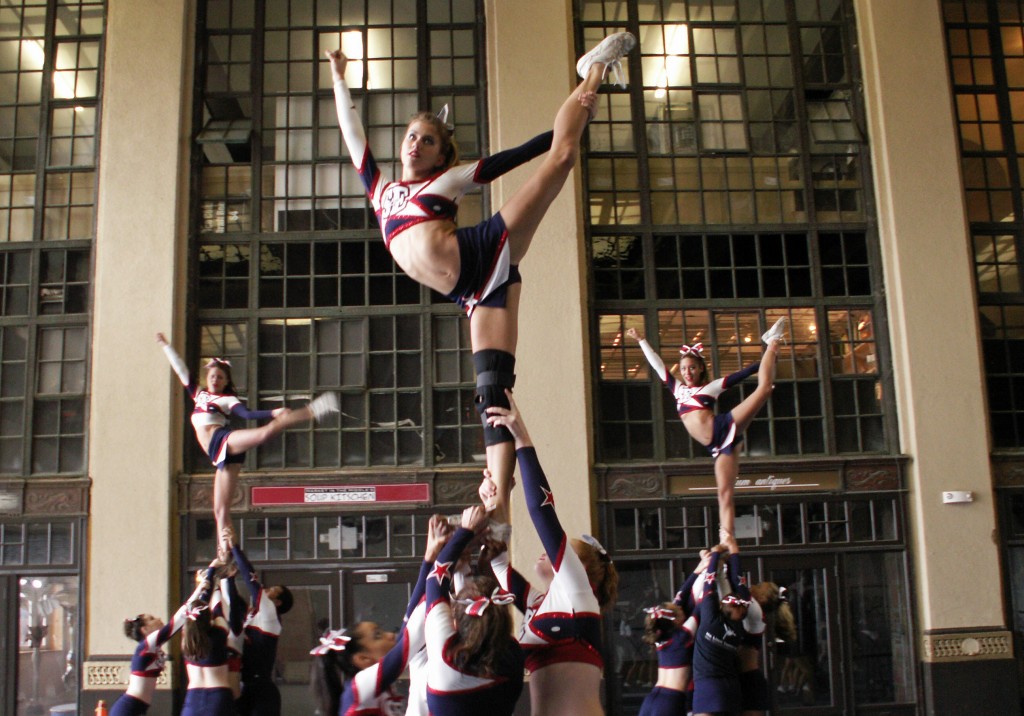Is Cheerleading Becoming Too Dangerous?
Physiowellbeing became involved in the sport of cheerleading after treatment of one of it’s athletes. Since then we have seen a rise in the number of cheerleading related injuries requiring treatment and been more involved in physiotherapy in the sport of cheerleading.
The sport of cheerleading has made it across the Atlantic and is now the fastest growing sport for females in the UK, although there is an increasing number of males now participating as well. It has been a recognised sport in the UK under Sport England as a gymnastic discipline for several years now also. It is a fantastic sport for (mainly) girls to improve their fitness levels, improve their life and working skills with team working, be part of something and look pretty at the same time. However cheerleading does not match it’s stereotype often seen in films and the actual competitive side of the sport is extremely physically and mentally demanding.
After the recent World Cheerleading Championships held at ESPN, Disneyland, Florida in April it is now being questioned if athletes are being pushed beyond safe physical and mental limits, mainly due to the increased complexity and sheer physicality of the moves and the skills required to execute them. The competition saw the highest number, and most horrific, injuries than were seen in any previous competition, with some of the best, well known athletes from the top US teams suffering severe injuries. Incidentally the competition had the highest number of UK teams competing than in previous competitions and all teams except two went through to the final day and were placed in top positions in their categories.
The rise in cheerleading injuries
Cheerleading injuries at one time were rarely seen in UK A & E departments but doctors are now used to treating these with the increase in the numbers of athletes taking part in Allstar competitive cheerleading. But even though cheerleading is fast becoming more popular in the UK it’s clear that there aren’t enough qualified, experienced coaches and certainly no specialist cheer gyms like they have in the US. Top American teams like Cheer Extreme, Top Gun, World Cup and the super-elite Allstar Cheerleaders all have elite facilities with sprung floors, gymnastic equipment and a high number of experienced coaches. Top US teams train for something like 25 hours each week with some of the athletes travelling more than 2 hours every day to train at the top gyms. It’s no wonder that the UK and the rest of the world have to try extra hard to compete against them!
Are these athletes being pushed too far?
As a result of having these top level facilities the Allstar teams rarely see career ending injuries, unlike the lower level high school, college and community teams and the UK teams. Having said that, Cheer Extreme were recently without two of their best tumblers due to injury. Could it be that even the Americans, in the face of stiffer competition and the pursuit of higher excellence, are being pushed too far?
Injuries recently suffered by cheerleaders at the world championships include broken legs and ankles, broken noses, broken arms and wrists, dislocation of the knee and in one case a broken neck. Sprains to wrists and ankles are also common and easier to treat with the use of rest, ice packs, compression bandaging and elevation. Here are some of the key statistics in the USA for concussions and catastrophic injuries in cheerleading;
- Cheerleading carries the highest rate of catastrophic injury in sports.
- Cheerleading accounts for 2/3 (66%) of catastrophic injuries in female athletes.
Cheerleading injuries have been attributed to lack of experience, inadequate conditioning, insufficient supervision, difficult stunts, and inappropriate surfaces and equipment. It is now for the cheerleading governing bodies and the teams to put in place preventative measures to treat these athletes as the sport becomes more popular and competitive here in the UK. Whether more risky moves should be carefully planned, perhaps a physiotherapist on hand for the team might prevent some injuries occurring by giving guidance on how far a cheerleaders body can be pushed. In addition to this physios can be on hand with preventative physiotherapy to ensure that any pre-existing injuries are treated and do not worsen.
Physio Wellbeing are now experienced in dealing with cheerleading injuries and preventative sports injury therapy. Contact us today for more details.

